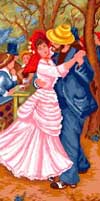
|
Music and Dance
Most dances are
accompanied by music. The first dance were part of religious ceremonies.
In Ancient Greece, as well as in the time of The Roman Empire, peoples
danced at feast and festivals.
In the Middle Age dance was
very popular (known) in Europe. We know that from the paintings and the
books of that period. The singers themselves accompanied some dances. In
the Renaissance and Baroque time many dances were presented at the royal
courts. The professors and the dance wasters were hired to teach peoples
how to dance and move gracefully. The popular dance was always included
in every day life. Every country has her tradition of music and popular
dances. Peoples dance with pleasure at festivities or even when they work.
The popular dance evolved for long-ways time being sent from a generation
to another. Popular dances have often influenced the dance styles. The
ballet is a kind of dance which express a tale by means of costumes and
scenes. The ballet appeared at the European courts at the end of the 16th
century. Piotr Ilich Ceaikovski (1840-1893) wrote the music for the most
well-knows ballets: "The Swans' Lake", "The Beauty from the sleepy forest"
(1890).
The dance for pleasure appeared
imitating the styles of dance. In the years '60 a sort of dance named "twist"
became famous. Peoples created their dancing footsteps with simple and
repeated motions. The "twist" became popular thanks to the song "Let's
Twist Again", sung by Chubby Checker.
|
Razvan Bratosin
"Duiliu Zamfirescu" School,
Focsani, Romania
Teacher Petru
Dumitru
|
Ballet is
a pantomime telling a story in dance and music. The ballet is often introduced
in an opera or stage piece aided by spectacular scenery and costumes. It
is not necessarili part of an opera but may be complete in itself. "Dance
of the Hours" is a classic ballet which was written for the opera "La Gioconda"
by Amilcare Ponchielli, an Italian composer, who was the teacher of Puccini.
The opera was first performed in Milan, April 1876.
The scene is laid in Venice
in the 17th century. Barnada, a spy, loves la Gioconda, a beautiful street
singer. But she spurns him because she is in love with Enzo, a Genoese
nobleman. In revenge, Barnaba incites the people against Gioconda's blind
mother, accusing her of witchcraft. Enzo who, having incurred the displeasure
of the "council", is obliged to disguise himself as a fisherman saves the
mother. In Act 3, the great hall of the Ducal Palace is filled with masquerades
for the ball. The Duke announces the ballet in which the dancers, costumed
as the Hours of Down, Day, Evening, and Night, portray the struggle between
day and night. In the finale, the hours of light conquer the hours of darkness.
Elena Prescornitoiu
"Duiliu Zamfirescu" School,
Focsani, Romania
Teacher Petru
Dumitru
|